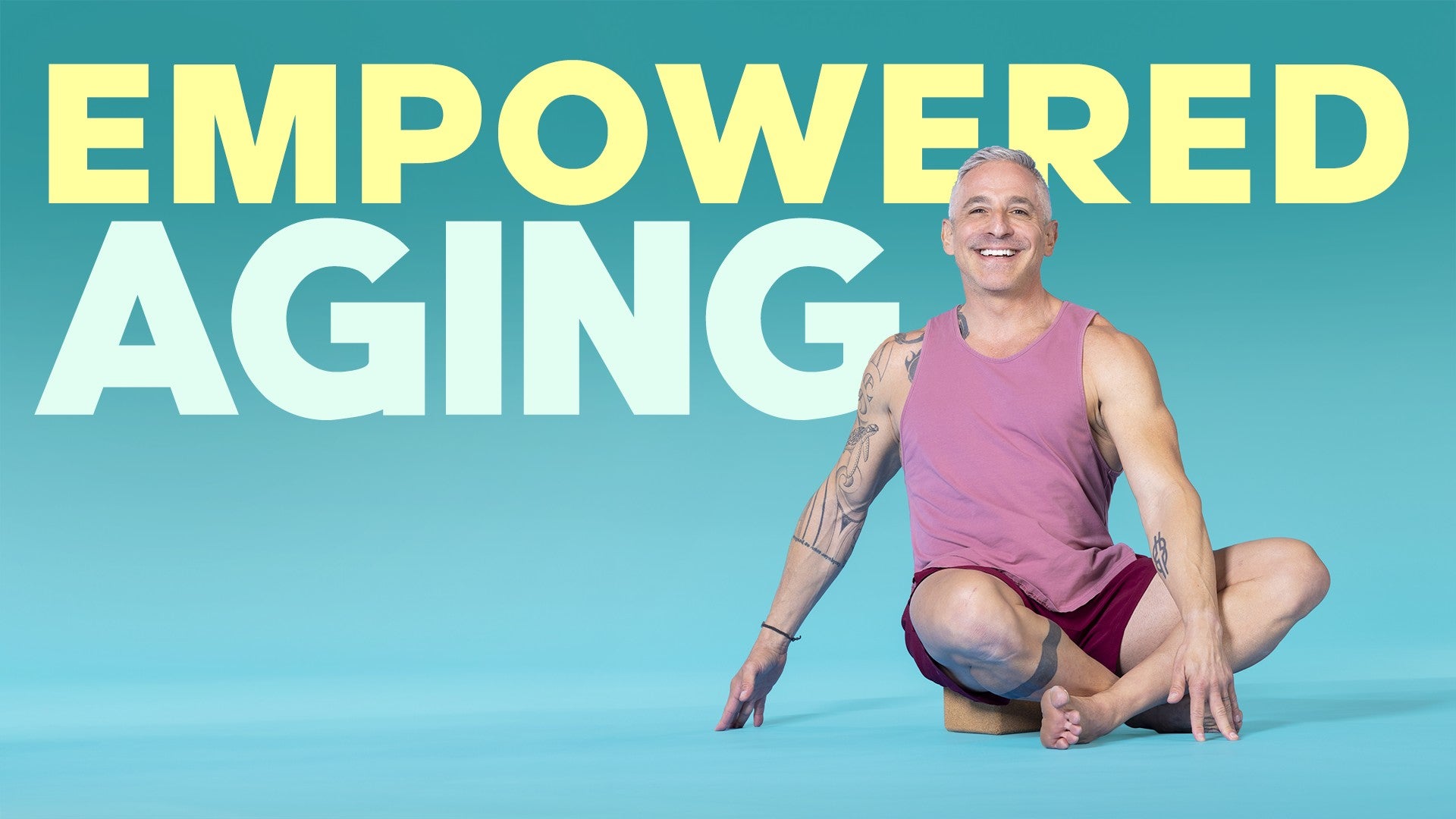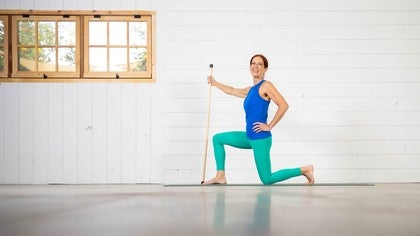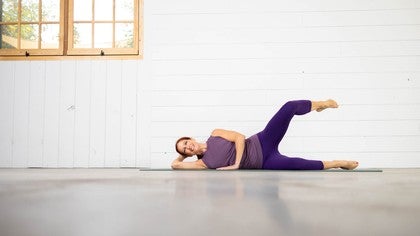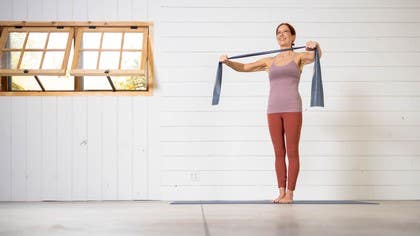Description
About This Video
Transcript
Read Full Transcript
Hi, everyone. In this class, we'll be focusing on spinal alignment, especially looking at pelvis as a foundation for your alignment all the way up, and we'll look at breathing and concepts of core control that you may be surprised about. So we'll start with the pelvis, placing the hands on the pelvis, and then place your feet slightly apart so you have really easy movement. And let's just rock and roll the pelvis forward and backward. And notice what happens to the rest of your body. Maybe your feet position changes.
Maybe your rib cage shifts forward and backward. Maybe your head goes forward and backward. Just notice those things without any judgment and feel that usually you have more range of motion going forward which is called anterior pelvic tilt and less range of motion going back. And you may be opposite of that. It depends on your typical movement posture or your, what we call, postural bias.
So some people are biased more with a kind of a posterily tilted pelvis where their rib cages back of the pelvis might look like this. And then other people might be focused more on a postural bias that puts the pelvis in more of an anterior tilt and rib cage lifted. So just notice those biases that you might have. We wanna have the pelvis be parallel to the wall in front of you, meaning that these 2 prominent bones at the front of your pelvis will be even with the pubic bone, and then notice that pubic bone go forward and backward. Alright.
Now let's place the hands on the low back. So what I mean by that is to place your hands right behind the belly button where you're massaging your back muscles. So how many of you think that you need a massage pretty often? Because your back is stiff or you have back pain, and it feels good to get a massage. What if you didn't need the massage? And you just got one because you wanted it. So let's talk about how your posture will actually facilitate what muscles are active on a daily basis.
If you have tension in your back muscles that happens regularly, and you find it hard to relax your back, then it may be the way that you're holding your skeletal posture that facilitates what muscles are active. When your postures in the right alignment, the deep muscles are more active and the superficial muscles are less active. The superficial ones are the ones that you can feel and see. The deep ones you can't really feel very well and you can't see, but they can tell you what's happening. The superficial muscles can tell you what's happening down below. Alright. So now place your hands on your low back, and let's do those same motions with the pelvis.
We're gonna go forward and backward. And what you might notice is when you tilt the pelvis forward or in that posterior tilt and your pubic gum goes forward, then you might notice your buttocks contract, but you'll also might notice your back muscles lengthened, but they still tense up. We call that an eccentric contraction. And then if your pelvis goes forward into that anterior tilt, you might find that those muscles tense up. You might have to bring your fingers really close together and put your fingers on your spinal bones.
Those are the spinous processes that stick out in the back. And then just keep doing that and see if you can find a place where your back muscles are the most relaxed. And then that's where you wanna hold your pelvis. Alright. Now let's move up to the rib cage, and we're gonna place our hands around the rib cage And it might be right where a strap goes around from wearing a a bra or a yoga top if you're a male, you'll be under the brass line and right under the rib cage or the where the shoulder blades sit on the rib cage. And then let's swing the rib cage forward and backward.
I often call this like the bell swinging forward and the bell swinging back. Do you have a preference? Is your bell usually forward? Or is your bell usually swinging back? What we want is to have that rib cage right on top of the pelvis just like your, like, the lid on the jar that the jar fits perfectly under that lid. Alright. So once you find that, then what I want you to do is place your hands on your rib cage and just take a deep breath. Did your ribs actually move?
And then let the breath out and see if your rib cage is actually moving there. Now go back and feel your low back muscles and see if they're relaxed or are they tense? So it can be lots of different factors feeding into that tension. You might have your weight too far forward on your feet. You could have your pelvis either too arched or too flexed underneath, or you might have your rib cage too far forward or too far back.
So we're looking for that ideal alignment so that those back muscles are relaxed. Another concept to think about with core control and whether or not this is activated or not is to look at our head posture. So now what I want you to do is put your hands on your belly And then we're gonna press the head forward and back. And you wanna notice if your belly muscles are contracting or relaxing, if the head is forward, a lot of times the belly will start to protrude because it really deactivates those muscles with the head being forward of the body because you're working more through the back of the body. Now, let's bring the head back again, keep your eyes focused on a vertical line right in front of you, and notice if those muscles tend to contract. You don't have to pull them in.
You don't have to tighten them. You just have to get everything lined up on the way up. That includes the head posture. So, again, feel the belly, let the head go forward, and then pull the head back And what you're doing here is you're contracting the deep neck flexors and lengthening through the back of the head and neck And that actually brings in both the deep neck flexors and the abdominals, and it lengthens the back of your neck as well. So those suboccipital muscles get a little space.
And I always like to call that the sacred space. You wanna keep that space open and not compressed. Alright. Bring the feet together now. I'd like you to see what happens at your pelvis with your feet together. When you shift side to side with your feet together, you can't go very far because your alignment is such on such a narrow base of support.
And then if you sim separate your feet, you have a lot more postural sway, a lot more ability to sway back and forth, And what I want you to notice is what muscles are activated when your feet are together versus when they're apart. So let's do this. We're gonna shift side to side. Let your heel come off the ground. Now, you're not actually shifting your pelvis side to side. We're doing like the leaning tower of pizza here.
And then taking it side to side. And you may or may not feel some muscles contracting under your hands And I challenge you to tell me which one of those muscles is more active under your hands at what point So when you put weight on your foot, is this muscle more or less active? Try that on the other side. And this muscle happens to be the gluteus medius, which is your postural muscle. So if you're gonna stand on one leg, it's that muscle that keeps the pelvis lifted and from dropping.
Why is that important? Right? Because when you stand on your one leg or 2 feet together, your pelvis is gonna need to be stable and have good support there for your spine. So now let's take one foot off the floor. And if you feel that you need your towel, you can grab that. You can also put your hand on something stable if you need that. So let's place our weight on that one foot and just kinda march in place. And you notice, as you shift your weight from side to side, that that muscle is going to contract under your fingers, Again, that's your pelvic stability muscle and the muscle that's gonna keep you upright on one leg.
Keeps you from collapsing down into your knee and into your foot. Okay. Now let's see if you can maintain that position, keeping the rib cage over the pelvis And then take one hand and keep it on your pelvis here and one hand on your low back. So now we gotta do a lot of things at one time. Right? And then stand on one leg and see if you can keep your low back muscles relaxed as you do that.
Check-in with your head and neck, pull your head and neck back into that lengthened posture, and then place that foot down. Alright. And can you be relaxed in that position? Can you stay lengthened and not feel like you're over recruiting any muscles or tensing or tightening that you can stay lengthened using maybe 25% effort versus squeezing or tightening, which is gonna create compression in your joints. We wanna have buoyancy and decompression in our joints with that elongation of the spine.
Okay. Now we're gonna see can we look at some breathing techniques while we're in our ideal posture? You'll need a yoga strap for that. You can also use a dog leash or a necktie or a bathrobe belt, something that doesn't have a lot of give You don't want it to be something stretchy. You want it to be firm. We're gonna place that strap around the rib cage.
Bring your hands all the way together. So we're not crossing it over like that. We wanna make sure that we're holding it and then just barely able to bring our thumbs together in the front. And then let's try to take a deep breath. Sometimes what happens is this.
Right? And that's actually a shallow breath because we're breathing more in that upper lung area. And what we want for efficient breathing is to breathe deeply, getting that diaphragm to move. So let's see if we can take a breath and expand the rib cage thinking of bucket handles lifting up like this. That's how your ribs work. And if you know your UJai breath, You can do that, keeping the mouth closed. And you'll notice with ideal breathing, that your rib cage will expand 2 inches, but you might also notice with a full exhalation that your rib cage will contract 2 inches.
So you should have 4 inches of excursion total between the inhale and the exhale. If you're missing a little bit, one direction or the other. What that usually means is that you need to focus on either expanding your rib cage, improving the mobility there. For an inhalation, or contracting the rib cage using your abdominal muscles and your full abdominal wall, including the obliques, to be able to pull those ribs down. If you have limited core control or you feel like your abdominals are not very strong, focusing on an exhalation as you're doing your yoga practice will really help strengthen your abdominals.
And get them more active to support your spine. So let's try that one more time. See how my thumbs are crossing over, and I'll show it from the back. Alright. So I hope that you're not too dizzy with that. Sometimes that can happen when you're and breathing for the first time.
And something that I wanna mention is that when you differentiate costal breathing from diaphragmatic breathing, they're actually both diaphragmatic breathing because the diaphragm is still going up and down with each of those techniques. But in the transverse abdominis or assisted breathing with the with the rib cage, that rib cage is expanding outward. The diaphragm is actually going down as you allow air to come in. Creating that negative air pressure makes air come in increasing the size of that space vertically And then when you exhale, that pushes the air out. Now you can actually relax and just let the air come out like a Right?
Or you can, what we call forced expiration, push the air out using your abdominals, and getting them more active So if you add that extra bit of expiration, timing, and flow then you'll often help to strengthen the abdominals and support your spine a little bit better. Now, let's take the hands to the belly, and you might have done this before with the diaphragmatic breathing. It's what I I like to call it belly breathing because it they're both diaphragmatic breathing, but one moves the rib cage more and is more active and more core control type breathing, and one is more of a relaxing breath. So let's place the hands on the low belly. Breathe in?
I'm just a relaxing breath in and out. So the belly moves in and out with this breath whereas it doesn't with the rib cage breath. So these breaths are great for changing the the quality of your nervous system. The diaphragmatic breath or the belly breath will actually stimulate the parasympathetic nervous system, calming your nervous system. This is what we call our feed and breed system.
The costal breath will actually activate more of your sympathetic nervous system. So if you're feeling a little down, little sluggish, a little tired, and you want to rejuvenate yourself, the cost of breathing would be great. If you're feeling tense or anxious, the diaphragmatic or belly breathing would be great. Alright. Now let's take that into our practice and see if we can align the spine align the feet, right, and keep everything aligned as we do some functional activities. You'll need your dowel or broomstick for that. Let's place the dow against the back.
So I like to call this my portable wall. We're gonna place the head, the mid back, and the sacrum against the dowel. Now, stick your thumb in between the dowel and your low back right behind your belly button. And then you'll wiggle it around to see how much space you have there. Every spine is a little bit different.
So some people might have more of a flat spine where they can only get one finger in there. Some people might have more of a rounded or inwardly curved spine, which is what we call an extension or lumbar lordosis. You might have a larger lordosis here. And then you can get maybe 3 fingers in there. For me, I I'm usually about a 2 finger lordosis.
It does range sometimes between 2 and 3. If I'm tucking my tail under and squeezing my buttocks, that is not going to be the ideal position of my spine because it puts the spine in more of a flexion position. Changes everything on the way up, and it also changes my hips. So let's keep that pelvis in neutral and just see where we land with that posture, again, stacking the rib cage over the pelvis and noticing if our head is touching the dowel. Alright. Now let's march in place like we did earlier.
Can you keep the 3 points of contact as you do something simple, like marching in place? What you might feel that you're doing is this. Right? That would mean that you're tucking your tail under to do this. And what we want is to stay as much as possible in that neutral pelvic position that provides the socket for the hip. If we do this, a socket for a hip faces forward. Other other things that might be happening are when you lift up, your head comes forward. Right?
So that can happen too as a movement pattern that we get a little bit stuck in. So let's see. Again, can we keep the head the mid back and the sacrum against the stick. Now, this may be something you'll wanna come back to because it requires a lot of practice. And a lot of body awareness. And this is what we're doing here is creating that awareness so that when we do our bone building exercises, we can actually bend over and pick something up off the floor without compromising the bones of our spine.
So this is gonna be a really important concept I'd I'd venture to say the most important thing that if you learn anything from me in this series, this is the concept you wanna practice. Okay? So what happens if you are a little stiff or maybe have some roundness in the upper back and you end up looking at the ceiling? When you bring your head back. So that is hard to use the towel for because you can't feel it back there.
So what you can do is if you can reach the dowel, you can place your hand against the back of your head here and then kind of clamp your forearm to the side of your head like that, and then that keeps your head still as you do the hip hinge. I'll try to show that from several different directions so you can see what I mean by that. The other thing that you can do if you have a forward head posture, maybe you can't get your arm back there. Maybe you need to use the other side. Right? And you can put your wrist in between the stick. That way you still have that feedback of that pressure against your head, even though your head might be forward of your body at this point.
But in future classes, I'm gonna show you some things that you can do to align your spine better so you can get that spine to straighten out a little bit and bring that head back over the body working on mobility of your thoracic spine. Alright. So now let's go to the back of the mat, and we're gonna prepare for a transition to the mat. Finding your best alignment here, doing your hip hinge, I wanna see that you can touch the floor in between your feet. And sometimes what happens is that we don't have enough hip mobility to be able to get to the floor. So here's something you can do.
You can take your feet wide on the mat, turn them out just a little bit, which is a little easier position for the hip to move, and maybe that allows you to flex enough at your hip joints to be able to get to the floor. Alright. Then what if that still doesn't work? Right? You end up doing this. And trying to get to the floor. You compromise your spine because your hips are stiff, and that happens quite a bit.
This can also happen. Right? So that comes off your tailbone. So what you want is to make sure that you stop at a certain point when you can no longer bend at your hip joint, and then your spine starts to bend. So you wanna stop there and maybe take a measurement. You can use a yoga block or something to touch and start working on that hip mobility.
And then when we get to another one of the classes in this series, we will actually be working on your hip mobility if you have stiffness so that you can get to the floor and be able to make that transition to the mat, pick things up, pick pets up, children up, gardening soil, mulch, whatever it is that you're doing. I love to garden, so I'm always looking at ways that I can garden safely and effectively and keep my body healthy, keep my bones strong. So thank you for joining me. I look forward to having you revisit the class. If you need more practice, and I look forward to seeing you in the next class.
Empowered Aging: Bone Health
Comments
You need to be a subscriber to post a comment.
Please Log In or Create an Account to start your free trial.







